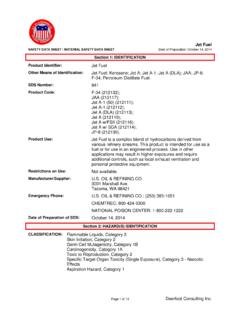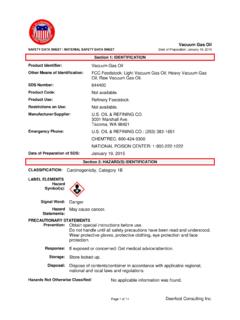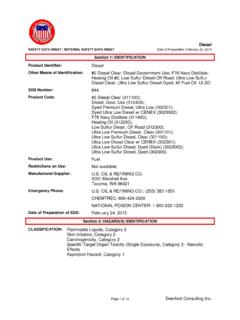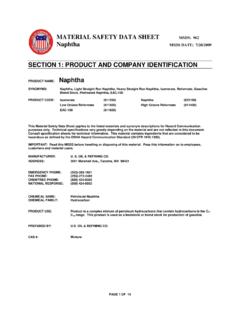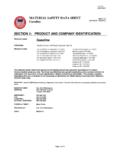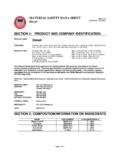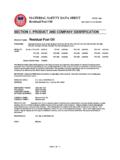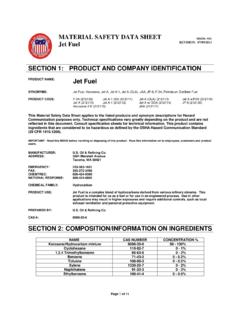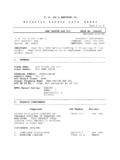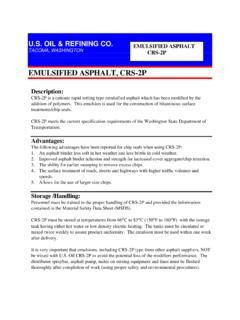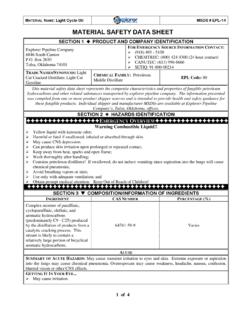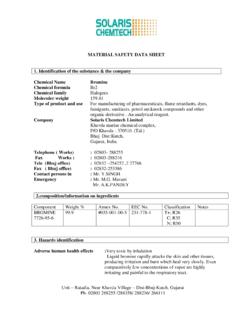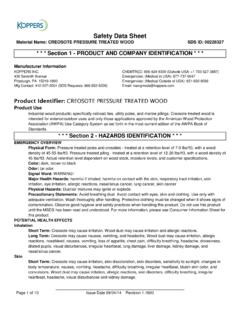Transcription of MATERIAL SAFETY DATA SHEET MSDS: 951 …
1 PAGE 1 OF 9 MATERIAL SAFETY data SHEET msds : 951 asphalt emulsions REVISION: 1 REVISION DATE: 09/03/09 SECTION 1: PRODUCT AND COMPANY IDENTIFICATION PRODUCT NAME: asphalt Emulsions, All Grades SYNONYMS: asphalt Emulsions (all grades), Emulsified Asphalts (all grades), Cationic Emulsified asphalt (all grades) PRODUCT CODE: CMS-2P (N/AV) CMS-2S (N/AV) STE-1 (534110) CSS-1 (533110) CSS-1H (533210) CMS-2 (531110) CRS-2 (532110) CRS-2P (532420) This MATERIAL SAFETY data SHEET applies to the listed products and synonym descriptions for Hazard Communication purposes only.
2 Technical specifications vary greatly depending on the product and are not reflected in this document. Consult specification sheets for technical information. This product contains ingredients that are considered to be hazardous as defined by the OSHA Hazard Communication Standard (29 CFR ). IMPORTANT: Read this msds before handling or disposing of this product. Pass this information on to employees, customers and product users. MANUFACTURER: U. S. OIL & REFINING CO. ADDRESS: 3001 Marshall Ave., Tacoma, WA 98421 EMERGENCY PHONE: (253)-383-1651 FAX PHONE: (253)-272-2495 CHEMTREC PHONE: (800) 424-9300 NATIONAL RESPONSE: (800) 424-8802 CHEMICAL FAMILY: asphalt Mixture PREPARED BY: OIL & REFINING CO.
3 CAS #: Mixture SECTION 2: COMPOSITION/INFORMATION ON INGREDIENTS NAME CAS NUMBER CONCENTRATION % Petroleum asphalt 8052-42-4 57 - 75% Water 7732-18-5 55 - 75% Naphtha 64741-46-4 0 - 10% Polymer Additive Mixture 0 5% Organic Amine Emulsifier Mixture 0 - 6% Hydrochloric Acid 7647-01-0 0 - 5% Hydrogen Sulfide 7783-06-4 Trace PAGE 2 OF 9 SECTION 3: HAZARDS IDENTIFICATION Warning!
4 Can cause eye and skin irritation. Hot product can cause burns. Fumes from product can cause irritation to the eyes, skin and respiratory system. PHYSICAL STATE: Liquid Color: Brown-Black Odor: Asphaltic, Sweet Odor ROUTES OF ENTRY: Dermal Contact. Eye Contact. Inhalation. Ingestion. POTENTIAL HEALTH EFFECTS EYES: Eye contact may result in eye irritation or burns. SKIN: Skin contact with hot product can cause thermal burns. Skin contact with product at warm or ambient temperatures may cause skin irritation.
5 Prolonged or frequent contact with product at warm or ambient temperatures may cause more serious skin disorders. INGESTION: This MATERIAL can irritate the mouth, throat, stomach, and cause nausea, vomiting, diarrhea. Ingestion of hot product can cause thermal burns. INHALATION: No significant health effects are expected to occur from short-term exposures to this product at ambient temperatures. If handled at elevated temperatures, vapors and mists can irritate the eyes, nose, throat and/or lungs. MEDICAL CONDITIONS GENERALLY AGGRAVATED BY EXPOSURE: Skin, eye and respiratory disorders may be aggravated by exposure to this product.
6 SECTION 4: FIRST AID MEASURES EYES: For contact with molten MATERIAL , flush eyes with clean low-pressure water for a minimum of 15 minutes. Seek immediate medical care. SKIN: Remove contaminated clothing. Wipe excess product off with a dry cloth. Wash affected area well with a waterless cleanser followed by soap and water. Thoroughly clean contaminated clothing. Seek medical attention if pain or irritation persists. INGESTION: Do not induce vomiting. Seek prompt medical attention if significant amounts are swallowed or irritation/discomfort occurs. INHALATION: If affected, move person to fresh air. Administer oxygen or administer CPR (cardiopulmonary resuscitation) for respiratory distress and seek prompt medical attention.
7 If symptoms or irritation occur, seek prompt medical attention. PAGE 3 OF 9 SECTION 5: FIRE-FIGHTING MEASURES FLAMMABILITY OF THE PRODUCT: NFPA Class IIIB combustible MATERIAL FLAMMABLE LIMITS IN AIR, Lower: Not Applicable (% BY VOLUME): Upper: Not Applicable FLASH POINT: Not Applicable AUTOIGNITION TEMPERATURE: Not Determined PRODUCTS OF COMBUSTION: Carbon dioxide, carbon monoxide, sulfur oxides, hydrogen sulfide, smoke, fumes, and unburned hydrocarbons FIRE-FIGHTING MEDIA AND INSTRUCTIONS: Use dry chemical, foam, carbon dioxide or water fog. Use water to keep fire exposed containers cool.
8 Minimize breathing of vapors, fumes or decomposition materials. Collect contaminated fire-fighting water separately. Do not allow liquid runoff to enter sewers or public waters. SPECIAL FIRE FIGHTING EQUIPMENT: Fire-fighters should wear appropriate protective equipment and self-contained breathing apparatus (SCBA) with a full face-piece operated in positive pressure mode. Cool tanks and containers exposed to fire with water. UNUSUAL FIRE AND EXPLOSION HAZARDS: asphalt emulsions will normally not ignite. However asphalt emulsion may separate forming a layer of asphalt and a layer of water in the storage tank.
9 asphalt and asphalt residue will burn at elevated temperatures. PAGE 4 OF 9 SECTION 6: ACCIDENTAL RELEASE MEASURES PERSONAL PRECAUTIONS: Immediately contact emergency personnel. Eliminate all ignition sources. Keep unnecessary personnel away. Use suitable protective equipment (section 8). Do not touch or walk through spilled MATERIAL . ENVIRONMENTAL PRECAUTIONS: Avoid dispersal of spilled MATERIAL and runoff and contact with soil, waterways, drains and sewers. If facility or operation has an "oil or hazardous substance contingency plan", activate its procedures. Stay upwind and away from spill. Wear appropriate protective equipment including respiratory protection as conditions warrant.
10 Do not enter or stay in area unless monitoring indicates that it is safe to do so. Isolate hazard area and restrict entry to emergency crew. Contain spill in smallest possible area. Prevent spilled MATERIAL from entering sewers, storm drains, other unauthorized treatment or drainage systems and natural waterways. Contact fire authorities and appropriate federal, state and local agencies. If spill of any amount is made into or upon navigable waters, the contiguous zone, or adjoining shorelines, contact the National Response Center at 800-424-8802. For highway or railway spills, contact Chemtrec at 800-424-9300. METHODS FOR CLEANING UP: For small spills, absorb or cover with dry earth, sand or appropriate absorbent MATERIAL .
